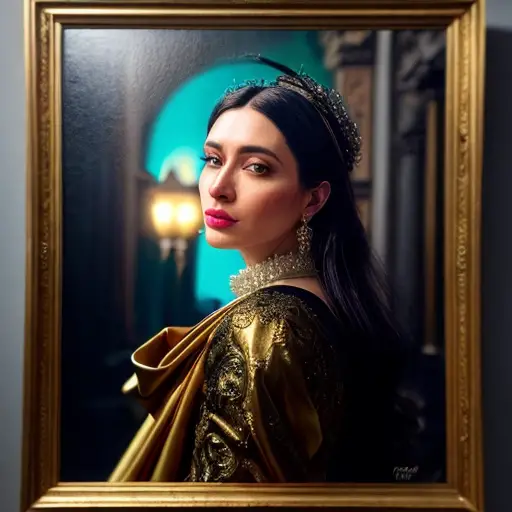Alright, picture this: you're an aspiring artist, ready to dive into the world of Baroque style painting. But wait, what's the secret ingredient that makes these paintings so captivating? It's all about the composition, my friend! To create a truly Baroque masterpiece, you need to embrace the art of complexity. Think grandeur, drama, and a touch of organized chaos. Baroque compositions are like a wild symphony, with swirling lines, intricate details, and a whole lot of energy. So, forget about simplicity and minimalism – it's time to unleash your inner maestro and create a composition that would make even the most flamboyant peacock jealous.
An interesting fact about the type of composition used to create a Baroque style painting is that it often employed a technique called 'tenebrism.' Tenebrism is characterized by a stark contrast between light and dark, with deep shadows and intense illumination. This technique was used to create dramatic and theatrical effects, enhancing the emotional impact of the artwork. By strategically placing light sources and manipulating shadows, Baroque painters were able to create a sense of depth and three-dimensionality in their compositions, making the subjects appear more lifelike and dynamic.
Imagine yourself transported back to the extravagant world of the Baroque era, where art was all about making a statement. When it comes to composition in Baroque art, it's all about the dynamic symmetries and dramatic contrasts. Picture a painting with a central focal point, surrounded by swirling lines and intricate details that guide your eye through the masterpiece. But don't stop there – add some dramatic lighting, with shadows and highlights that create a sense of depth and intensity. And let's not forget about those bold color choices, where vibrant hues collide and create a visual feast for the eyes. So, if you're ready to embrace the drama and create a composition that screams Baroque, remember to go big, go bold, and let your artistic flair run wild.

In the world of Baroque style paintings, creating a sense of movement and drama is key. To achieve this, artists employ various composition strategies that captivate the viewer's attention and leave them in awe. One such strategy is the use of diagonal lines. By incorporating diagonal lines into the composition, artists can create a dynamic and energetic atmosphere. These lines guide the viewer's eye, leading them on a visual journey through the painting, as if caught in a whirlwind of emotion and action.
Another composition technique that adds to the drama of Baroque style paintings is the concept of foreshortening. This technique involves depicting objects or figures in a way that gives the illusion of depth and three-dimensionality. By exaggerating the perspective and distorting proportions, artists can create a sense of movement and intensity. This technique is often used to depict figures in dramatic poses, as if frozen in a moment of action, further enhancing the overall sense of drama in the painting.
Furthermore, the strategic use of light and shadow plays a crucial role in creating a sense of movement and drama in Baroque style paintings. Artists utilize a technique called chiaroscuro, which involves the strong contrast between light and dark areas. This dramatic interplay of light and shadow not only adds depth and dimension to the composition but also creates a sense of tension and intrigue. The interplay of light and shadow can highlight certain elements of the painting, drawing the viewer's attention and intensifying the overall dramatic effect.
Lastly, the concept of asymmetry is often employed in Baroque style paintings to create a sense of movement and visual interest. Rather than adhering to strict symmetry, artists embrace a more dynamic and unbalanced composition. This asymmetry adds a sense of spontaneity and unpredictability, as if the scene is unfolding before the viewer's eyes. It allows for a more organic and lively composition, contributing to the overall sense of movement and drama that defines Baroque art.
In conclusion, creating a sense of movement and drama in Baroque style paintings requires careful consideration of composition strategies. From the use of diagonal lines to foreshortening, and from chiaroscuro to asymmetry, each element plays a vital role in capturing the viewer's attention and evoking a sense of awe and wonder. So, if you're ready to embark on a journey of artistic expression, embrace these composition strategies and let your Baroque masterpiece come to life with movement and drama.
A fun fact about creating a baroque style painting is that artists often used a dynamic and theatrical composition known as 'diagonal composition.' This technique involved arranging the main elements of the painting along diagonal lines, creating a sense of movement and energy. This composition style was believed to evoke a dramatic and emotional response from viewers, making baroque paintings visually captivating and engaging.
Step into the world of Baroque art, where theatricality and illusion reign supreme. To create a Baroque style painting, one must master the art of composition that embraces these elements. The composition of a Baroque masterpiece is like a stage, carefully designed to captivate and mesmerize the viewer. Artists employ techniques such as the use of diagonals, foreshortening, and dramatic lighting to create a sense of depth and movement. They skillfully arrange figures and objects in a way that creates a dynamic and visually engaging scene. The goal is to transport the viewer into a world of grandeur and spectacle, where reality and illusion intertwine. So, if you're ready to unlock the secrets behind Baroque masterpieces, embrace the theatricality and illusion in your composition, and let your painting become a stage for awe-inspiring artistry.